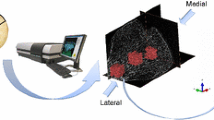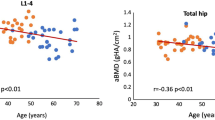Abstract
Summary
This study investigated regional variations in the 3D microstructure of trabecular bone in human proximal femur, with respect to aging. The results demonstrate that age-related changes in trabecular microstructure significantly varied from different sub-regions of the proximal femur.
Introduction
We hypothesize that the age-related changes in trabecular bone microstructure appear to be varied from specific anatomic sub-regions of the proximal femur followed by non-uniform bone loss. The purpose of this study was therefore to explore regional variations in the 3D microstructure of trabecular bone in human proximal femur, with respect to aging.
Methods
A total of 162 trabecular bone cores from six regions of 27 femora of male cadaver donors were scanned using micro-computed tomography (micro-CT). The following microstructural parameters were calculated: bone volume fraction (BV/TV), trabecular number (Tb.N), thickness (Tb.Th) and separation (Tb.Sp), structure model index (SMI), and degree of anisotropy (DOA).
Results
Age-related changes in trabecular microstructure varied from different regions of the proximal femur. There was a significant decrease in bone volume fraction and an almost identical decrease in trabecular thickness associated with aging at any region. Regional analysis demonstrated a significant difference in BV/TV, Tb.Th, Tb.Sp, Tb.N and DOA between superior and inferior neck, as well as a significant difference in BV/TV, Tb.Sp, Tb.N, SMI and DOA between superior and inferior trochanter.
Conclusions
Age-related changes in bone loss and trabecular microstructure within the male proximal femur are not uniform in this cadaveric population.



Similar content being viewed by others
References
Dubey A, Koval KJ, Zuckerman JD (1999) Hip fracture epidemiology: a review. Am J Orthop 28:497–506
Riggs BL, Melton LJ 3rd (1995) The worldwide problem of osteoporosis: Insights afforded by epidemiology. Bone 17(suppl 5):505–511
Siddiqui NA (1999) Osteoporosis in older men: discovering when and how to treat it. Geriatrics 54:21–32
Eastell R, Boyle IT, Compston J et al (1998) Management of male osteoporosis: report of the UK consensus group. Q J Med 91:71–92
Gullberg B, Johnell O, Kanis JA (1997) World-wide projections for hip fracture. Osteoporosis Int 7:407–13
Dahl E (1980) Mortality and life expectancy after hip fractures. Acta Orthop Scand 5:163–70
Holmberg S, Thorngren KG (1987) Statistical analysis of femoral neck fractures based on 3053 cases. Clin Orthop 218:32–41
Nydegger V, Rizzoli R, Rapin CH et al (1991) Vasey H, Bonjour JP: Epidemiology of fractures of the proximal femur in Geneva: incidence, clinical and social aspects. Osteoporos Int 2:42–47
Seeman E (1999) Osteoporosis in men. Osteoporos Int 9(Suppl 2):97–110
Colon-Emeric CS, Sloane R, Hawkes WG et al (2000) The risk of subsequent fractures in community-dwelling men and male veterans with hip fracture. Am J Med 109:324–326
Cummings SR, Nevitt N, Browner W (1995) Risk factors for hip fracture in white women. Study of osteoporotic fractures research group. N Engl J Med 332:767–773
Ross PD, Davis JW, Vogel JM (1990) A critical review of bone mass and the risk of fractures in osteoporosis. Calcif Tissue In 46:149–161
Stone K, Seeley D, Lui L-Y et al (2003) BMD at multiple sites and risk of fracture of multiple types: long-term results from the study of osteoporotic fracture. J Bone Miner Res 18:1947–1954
Greenspan SL, Myers ER, Maitland LA et al (1994) Fall severity and bone mineral density as risk factors for hip fracture in ambulatory elderly. JAMA 271:128–133
NIH Consens Statement (2000) Osteoporosis prevention, diagnosis, and therapy No.17:1–45
Ulrich D, van Rietbergen B, Laib A et al (1999) The ability of three- dimensional structural indices to reflect mechanical aspects of trabecular bone. Bone 25:55–60
Ciarelli TE, Fyhrie DP, Schaffler MB et al (2000) Variations in three- dimensional cancellous bone architecture of the proximal femur in female hip fractures and in controls. J Bone Miner Res 15:32–40
Sugita H, Oka M, Toguchida J et al (1999) Anisotropy of osteoporotic cancellous bone. Bone 24(5):513–516
Gong H, Zhang M, Yeung HY et al (2005) Regional variations in microstructural properties of vertebral trabeculae with aging. J Bone Miner Metab 23(2):174–180
Ding M, Odgaard A, Linde F et al (2002) Age-related variations in the microstructure of human tibial cancellous bone. J Orthop Res 20(3):615–621
Khosla S, Riggs BL, Atkinson EJ et al (2006) Effects of sex and age on bone microstructure at the ultradistal radius: a population-based noninvasive in vivo assessement. J Bone Miner Res 21(1):124–131
Lundeen GA, vajda EG, Bloebaum RD (2000) Age-related cancellous bone loss in the proximal femur of Caucasian females. Osteoporos Int 11(6):505–511
Bloebaum RD, Lauritzen RS, Skedros JG et al (1993) Roentgenographic procedure for selecting proximal femur allograft for use in revision arthroplasty. J Arthroplasty 8:347–360
Hildebrand T, Laib A, Muller T et al (1999) Direct three-dimensional morphometric analysis of human cancellous bone: microstructural data from spine, femur, iliac crest, and calcaneus. J Bone Miner Res 14:1167–1174
Lotz JC, Cheal EJ, Hayes WC (1995) Stress distributions within the proximal femur during gait and falls: implications for osteoporotic fracture. Osteoporos Int 5:252–261
Marotti G, Ferreti M, Muglia MA et al (1992) A quantitative evaluation of osteoblast-osteocyte relationships on growing endosteal surface of rabbit tibiae. Bone 13:363–368
Issever AS, Vieth V, Lotter A, Meier N, Laib A, Newitt D, Majumdar S, Link TM (2002) Local Differences in the trabecular bone structure of the proximal femur depicted with high-spatial resolution MR imaging and multisection CT. Acad Radiol 9:1395–1406
Lai YM, Qin L, Yeung HY, Lee KKH, Chan KM (2005) Regional differences in trabecular BMD and micro-architecture of weight-bearing bone under habitual gait loading—A pQCT and micro-CT study in human cadavers. Bone 37:274–282
Mosekilde L (1998) Age-related changes in vertebral trabecular bone architecture- assessed by a new method. Bone 9:247–250
Parkinson IH, Fazzalari NL (2003) Interrelationships between structural parameters of cancellous bone reveal accelerated structural change at low bone volume. J Bone Miner Res 18:2200–2205
Tsangari H, Findlay DM, Fazzalari NL (2007) Structural and remodeling indices in the cancellous bone of the proximal femur across adulthood. Bone 40(1):211–217
Ding M, Odaard A, Danielsen CC et al (2002) Mutual associations among microstructural, physical and mechanical properties of human cancellous bone. J Bone Joint Surg (Br) 84(6):900–907
Gibson LJ, Ashby MF (1997) Cellular solids: structures & properties, 2nd edn. Pergamon, Oxford, p 510
Muller R, Gerber SC, Hayes WC (1998) Micro-compression: a novel technique for the nondestructive assessment of local bone failure. Technol Health Care 6:433–444
Conflicts of interest
None.
Author information
Authors and Affiliations
Corresponding author
Rights and permissions
About this article
Cite this article
Cui, WQ., Won, YY., Baek, MH. et al. Age-and region-dependent changes in three-dimensional microstructural properties of proximal femoral trabeculae. Osteoporos Int 19, 1579–1587 (2008). https://doi.org/10.1007/s00198-008-0601-7
Received:
Accepted:
Published:
Issue Date:
DOI: https://doi.org/10.1007/s00198-008-0601-7




